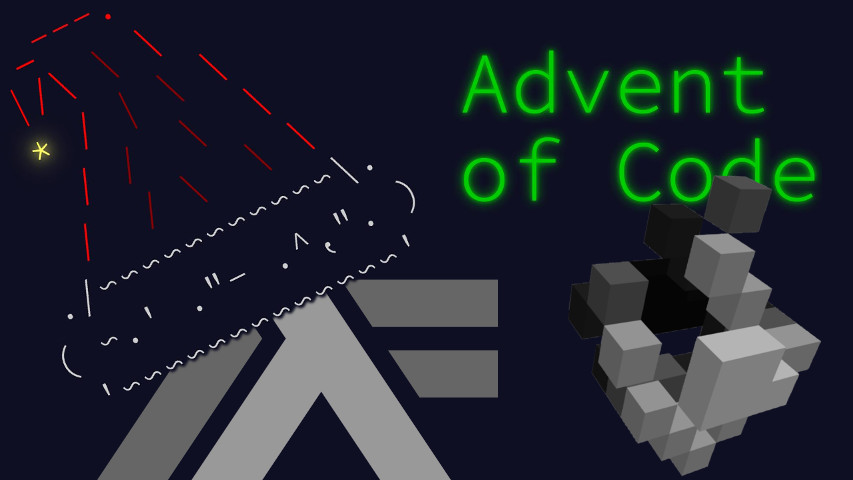Another cellular automaton for today’s Advent of Code! Twice in a year, aren’t we the lucky ones!
Here’s some imports and language extensions to make the introduction spicy.
{-# LANGUAGE ConstraintKinds #-}
{-# LANGUAGE TypeApplications #-}
import Prelude hiding ((.))
import Control.Category
import Control.Lens
import Data.Foldable (toList)
import Data.Ix (Ix,range)
import Data.Set as Set (Set,singleton,fromList,filter,member)
import Data.List (elemIndices)
import LinearThe sample is the classic 2D glider. This hints at “shifting
borders”, so I’ll represent the environment as a simple Set
of positions in case part 2 is about following it.
Parsing input can be coded as a simple composition of functions.
parseInput = lines
>>> map (elemIndices '#')
>>> zipWith (\i js -> map (V2 i) js) [0..]
>>> concat
>>> fromListWhat about the return type? It’s obviously a
Set (V2 Int). But the puzzle is in 3D, so I’ll make it
generic over the vector dimensionality. Well, not really, that would
bring us into type-level magic that’s just not warranted here; I’ll
settle for making it generic over the vector type.
parseInput :: String -> Env V2
type Env v = Set (v Int)The automaton rule is the standard one, with no specific adjustment for dimension.
rule :: Bool -> Int -> Bool
rule True n | n `notElem` [2,3] = False
rule False 3 = True
rule active _ = activeNow to compute the neighborhood. An easy way to do this is to use the
vectors’ Ix instance, as I did on day 11. But how am I to
generate the bounds? I’ll use the Applicative instance!1
λ> pure 42 :: V3 Int V3 42 42 42
neighbors r = fromList
[ r ^+^ delta | delta <- range (pure (-1),pure 1), delta /= zero ]What’s the typing for this? It needs quite a few constraints to work right.
- The result is a
Set. This needs anOrdinstance on the vector instance type. - It adds (
^+^) vectors. This needs anAdditiveconstraint on the vector type. - It generates the unit “circle” using
range. This needs anIxconstraint on the vector instance type. - It uses the
Applicativetrick for reasons detailed above.
That’s a mouthful. Let’s package them for ease of reading.
neighbors :: Conway v => v Int -> Env v
type Conway v = (Ord (v Int),Additive v,Ix (v Int),Applicative v)(This needs the ConstraintKinds extension.)
Now to implement the generational iteration. With such a setup, it’s rather straightforward.
step :: Conway v => Env v -> Env v
step activeCubes = foldMap life (activeCubes <> fringe) where
fringe = foldMap neighbors activeCubes
life cube = case rule (isActive cube) (countNeighbors cube) of
True -> singleton cube
False -> mempty
isActive cube = cube `member` activeCubes
countNeighbors = length . Set.filter isActive . neighborsAnd… that’s it! All we have to do now is run a few iterations on the sample.
λ> mapM_ print $ Data.List.take 5 $ iterate step sample fromList [V2 0 1,V2 1 2,V2 2 0,V2 2 1,V2 2 2] fromList [V2 1 0,V2 1 2,V2 2 1,V2 2 2,V2 3 1] fromList [V2 1 2,V2 2 0,V2 2 2,V2 3 1,V2 3 2] fromList [V2 1 1,V2 2 2,V2 2 3,V2 3 1,V2 3 2] fromList [V2 1 2,V2 2 3,V2 3 1,V2 3 2,V2 3 3]
It’s not too visual, but comparing the first and last line you can
verify that our little glider has successfully shifted by
V2 1 1.
But wait! We’re supposed to operate in 3D!
Well, if my generic style of implementing it worked, it should all be a matter of using the code from a 3D starting point instead of the flat one provided as input. Let’s write a function to convert the input from 2D to any higher dimensionality.
upgrade :: (R2 v,Conway v) => Env V2 -> Env v
upgrade = fromList . map ((zero &) . set _xy) . toListThe linear package kindly provides the R22 class to access 2D subsets of
vectors, so the conversion simply copies the 2D components of the input
to the two first coordinates of the receiving higher-dimensional null
vector.
And we can now solve part 1.
main :: IO ()
main = do
input <- parseInput <$> readFile "sample17.in"
print $ length $ iterate step (upgrade @V3 input) !! 6Part 2 asks us to do the same thing in 4D.
Ok.
print $ length $ iterate step (upgrade @V4 input) !! 6This concludes this day’s solution. I hope you enjoyed it, and see you soon for a subsequent instalment!



